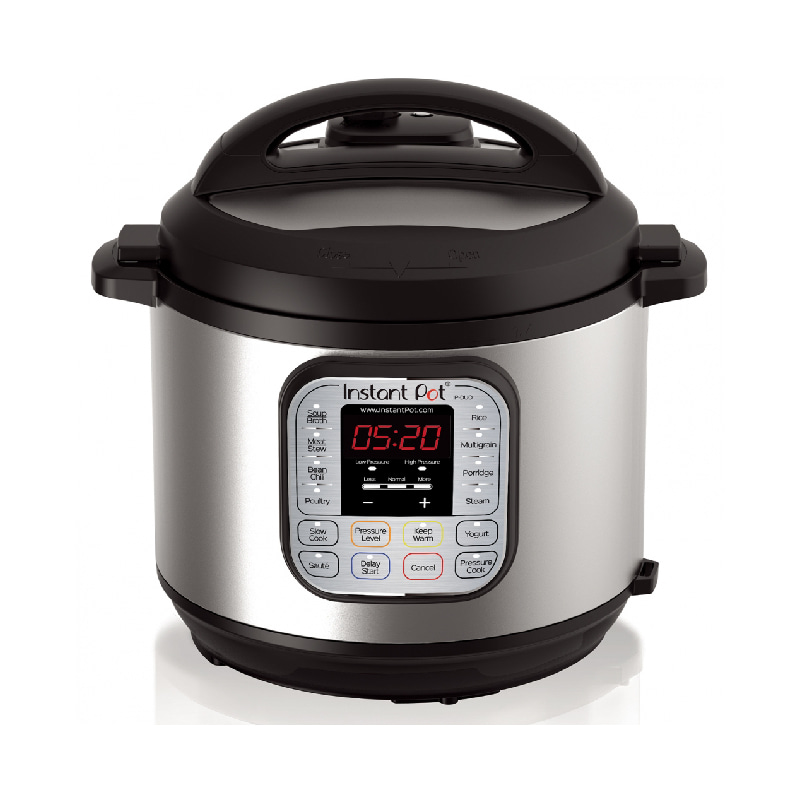The inner pot of the cooker (the stainless steel cooking pot), the sealing ring, the lid, and the steam rack are all dishwasher safe—yet another way in which your cooker makes cooking and cleanup extremely easy. Here is an overview of how best to care for and clean your Instant Pot®.
Prior to cleaning, ensure the cooker is unplugged and has cooled down.
The cooker base is home to the microprocessor and the heating element essential to cooking.
Do Not Place in the Dishwasher! If the cooker base gets wet, allow it to dry completely. Contact the Customer Care team https://instantpotme.com/product-registration/.
Clean the exterior of the cooker base with a damp cloth. You can use a slightly damp cloth to clean the inside of the cooker. It is however, important that the cooker be kept dry.
If you need to clean the area around the lip of the cooker, use a damp cloth or an old toothbrush to clean the edges.

The inner pot and the steam rack are made of sturdy, food-grade stainless steel (304 – 18/8) and are entirely dishwasher safe. For the most part, you can keep the inner pot cleaned just as you would clean any stainless steel pot—by hand washing or the dishwasher.
Should the inner pot develop harmless water stains, non-abrasive scouring cleanser, made especially for cooking pots, brings back the original shine.
You can also periodically clean the inner pot by placing 1 cup of white vinegar in the bottom of the inner pot. Allow it to rest for 5 minutes, and then pour out the vinegar and rinse.
Removing Bluish Marks from Your Stainless Steel Inner Pot

Instant Pot’s inner pot (cooking pot) is stainless steel, food grade 304 (18/8) with no chemical coating. It is durable and will retain its appearance for years to come with proper care.
With stainless steel cookware it is not uncommon for a bluish or “rainbow” discoloration to appear on the inside of the pot, and Instant Pot’s inner pot is no exception. Minerals or salt in the food and water are the cause for this discoloration. It may be easily removed by using a non-abrasive stainless steel cleaner, which will not only remove the marks it will help to retain the original brightness.
Another option is to cover the bottom with white vinegar. Allow the vinegar to sit for 5 minutes, remove, and rinse the inner pot. The discoloration marks should be removed completely.
For “White Hard Water” stains, they can be removed with a damp sponge soaked in vinegar or lemon.
We recommend avoiding steel wool, as it will scratch the surface. For additional information, verify “eHow” or “British Stainless Steel Association”.
The images illustrate an Instant Pot® inner pot after an 8-month period of regular use and the results after using white vinegar to clean the stains.


The lid is top-rack dishwasher safe. It is best to remove the sealing ring and the anti-block shield so that the lid may be thoroughly cleaned. One way to prevent the lid from retaining odors is to place it upside down on the pot until it has completely dried or you are ready to use it. Verify the steam release valve and float valve, and make sure there is no food or other debris that would block them, and prevent your cooker from coming to pressure

The anti-block shield underneath the lid should be removed and cleaned after each use, especially following the preparation of foods that may splatter.
To remove, using your thumb, push the side of the anti-block shield towards the lid rim and lift up. It may take a little effort, but the anti-block shield should pop out.
You can now wash the shield with warm, soapy water. Rinse, wipe dry with a soft cloth, and place back in position when dry. To position the anti-block shield in place, push down.

The sealing ring is made of high-quality, heat-resistant silicone. It can be hand-washed with soapy water or placed in the dishwasher. Allow the ring to dry completely before inserting back into the lid. Ensure the sealing ring is positioned in the lid after every wash, and that it is securely in place before you start cooking.
The sealing ring is critical in the functioning of your cooker. Inspect it carefully after it is washed. Any sign of cracking or other damage, replace the sealing ring. Replace only with Genuine Instant Pot® sealing rings, using other brands may void your Instant Pot® Warranty.
As silicone may pick-up food odors during cooking you may wish to have one sealing ring for savory and another for sweet foods.
Under normal conditions it should be fine for 18 – 24 months. If you notice cracks, leaking or deformation in the sealing ring, it should be replaced immediately. However, the sealing ring is porous and may absorb odors and become discolored. To avoid discoloration and odors, you may wish to change the sealing ring every 6 – 12 months.

The condensation collector is to be removed and hand washed periodically. Allow to dry before replacing.
